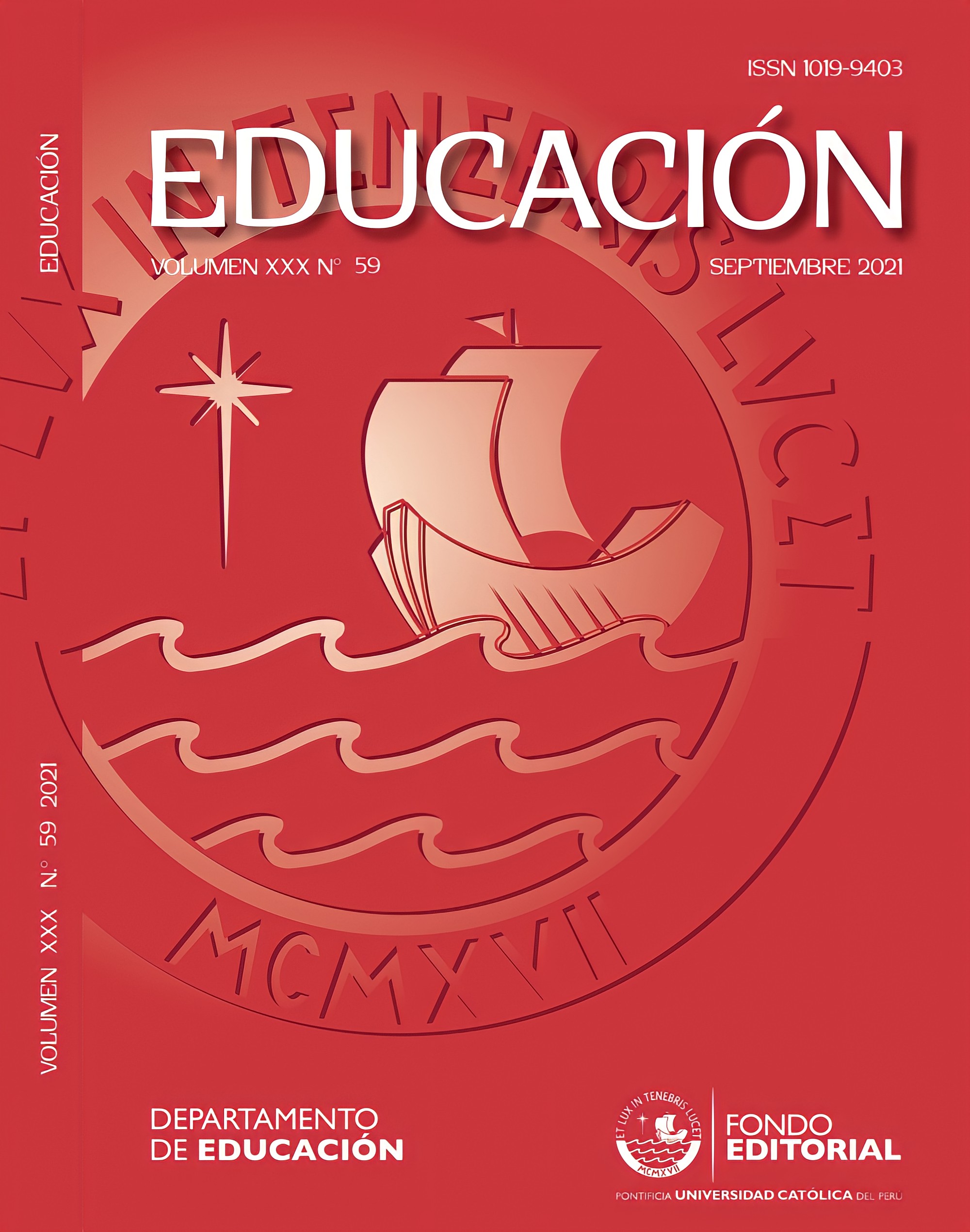“Del árbol al cuadro”: Un proyecto didáctico STEAM para Educación Primaria
DOI:
https://doi.org/10.18800/educacion.202102.014Palabras clave:
Ciencias Naturales, Educación Artística, Educación primaria, Papel, STEAMResumen
El proyecto “Del árbol al cuadro” es una innovación educativa interdisciplinar, basado en la enseñanza STEAM. Este proyecto dirigido al último tramo de Educación Primaria, presenta un trabajo interdisciplinar entre las áreas de Ciencias de la Naturaleza y Educación Artística, desarrollando una serie de actividades que tienen un denominador común: conocer el principal paisaje de la comarca Vega Alta del Segura de Murcia (Cieza), y sus posibilidades como fuente de materia papelera. Este proyecto basa su trabajo en la combinación de actividades didácticas de diversas áreas de conocimiento, pero vinculadas con las ciencias y el arte. Dando como resultado una programación de 5 sesiones, desde una salida didáctica hasta una exposición artística, pasando por la recolección de materia prima, creación de la pasta papelera y por la prueba con diversas técnicas pictóricas.
Descargas
Citas
Akerson, V. L., Burgess, A., Gerber, A., Guo, M., Khan, A. T. y Newman, S. (2018). Disentangling the Meaning of STEM: Implications for Science Education and Science Teacher Education. Journal of Science Teacher Education, 29(1), 1-8 https://doi.org/10.1080/1046560X.2018.1435063
Asunción, J. (2009). El papel: técnicas y métodos tradicionales de elaboración. Baladona: Parramón.
Barker, L. (2006). Laurence Barker: Paper artist and printmaker. Recuperado de http://www.laurencebarker.com/pdf/Brochure8.5x11_web.pdf
BOE. (2014). Real Decreto N° 126/2014, de 28 de febrero, por el que se establece el currículo básico de la Educación Primaria, 19349-19420. Madrid.
Cilleruelo, L. y Zubiaga, A. (2014). Una aproximación a la educación STEAM. Prácticas educativas en la encrucijada arte, ciencia y tecnología. Investigar en psicodidáctica: una realidad en auge, 22-38. Bilbao: Universidad del País Vasco.
Delgado, E. (2013). Los paisajes en la escuela. Palencia: Universidad de Valladolid.
Dougherty, D. (2013). The Maker Mindset. En M. Honey y D. E. Kanter (Ed.) Design, make, play: Growing the next generation of STEM innovators. (pp. 7-11). Londres: Routledge.
Fernández, N. y Pujalte, A. (2019). Manual de elaboración de secuencias didácticas para la enseñanza de las Ciencias Naturales. Ushuaia: Universidad Nacional de Tierra del Fuego.
García, A. (2011). El paisaje: un desafío curricular y didáctico. Revista Didácticas Especificas, 4, 1-19.
García, J. (2011). Ripollés. Recuperado de http://www.ripolles.es/
García, J. A. (2007). Fibras papeleras. Barcelona: UPC.
Greca, I. M., Ortiz-Revilla, J. y Arriassecq, I. (2021). Diseño y evaluación de una secuencia de enseñanza-aprendizaje STEAM para Educación Primaria. Revista Eureka sobre Enseñanza y Divulgación de las Ciencias, 18(1), 1802. https://doi.org/10.25267/Rev_Eureka_ensen_divulg_cienc.2021.v18.i1.1802
Greca, I. M. y Meneses Villagrá, J. A. (2018). Proyectos STEAM para la Educación Primaria. Fundamentos y aplicaciones prácticas. Madrid, España: Dextra.
Greenwald, C. (2004). The art of Caroline Greenwald. Recuperado de http://carolinegreenwald.com
Herzog, E. (2011). Elana Herzog. Recuperado de http://www.elanaherzog.com/
Libow, S. y Stager, G. (2013). Invent to Learn: Making, Tinkering, and Engineering in the Classroom. Torrance, CA: Constructing Modern Knowledge Press.
Madrid, J. M. y Pérez, M. A. (2006). El paisaje natural como centro de interés didáctico. Consejería de Educación de la Junta de Andalucía. Sevilla.
Ortiz-Revilla, J., Greca, I. M. y Arriassecq, I. (2018). Construcción de un marco teórico para el enfoque STEAM en la Educación Primaria. En C. Martínez Losada y S. García Barros (eds.), 28 Encuentros de Didáctica de las Ciencias Experimentales. Iluminando el cambio educativo (pp. 823-828). A Coruña, España: Universidade da Coruña. https://doi.org/10.17979/spudc.9788497496896
Pastor, A. (2017). Análisis de la metodología STEM a través de la percepción docente. Universidad de Valladolid. España.
Pérez, J. D. (2015) STEM, STEAM... ¿pero eso qué es? Didactalia. Recuperado de http://odite.ciberespiral.org/comunidad/ODITE/recurso/stem-steam-pero-eso-que-es/58713dbd-414c-40eb-9643-5dee56f191d3
Quigley, C. F. y Herro, D. (2016). “Finding the joy in the unknown”: implementation of STEAM teaching practices in middle school science and math classrooms. Journal of Science Education and Technology, 25(3), 410-426. https://doi.org/10.1007/s10956-016-9602-z
Resnick, M. y Rosenbaum, E. (2013). Designing for tinkerability. En M. Honey y D. E. Kanter (Eds.), Design, make, play: Growing the next generation of STEM innovators (pp. 163-180). Londres: Routledge.
Sanmartí Puig, N. (2002). Didáctica de las ciencias en la educación secundaria obligatoria. Madrid: Síntesis.
Villalba, J., Castillo, C. y Cuervo, A. (2018). La pasta de papel como material de creación artística. Arte, Individuo y Sociedad, 30(1), 195-210. https://doi.org/10.5209/ARIS.57742
Villalba, J. V. (2015). Enseñanzas de la transformación a papel y obra artística a partir de hoja caduca de árboles frutales. Murcia: Editum.
Villalba, J. V. (2018). Didáctica artística y medioambiental: la estampación de materias vegetales como recurso educativo. Educatio Siglo XXI, 36(3), 275-298. https://doi.org/10.6018/j/350001
Volij, A. (2008). Papel artesanal. Recuperado de http://alejandrovolij.com.ar
Zollman, A. (2012). Learning for STEM literacy: STEM literacy for learning. School Science and Mathematics, 112(1), 12-19. https://doi.org/10.1111/j.1949-8594.2012.00101.x









